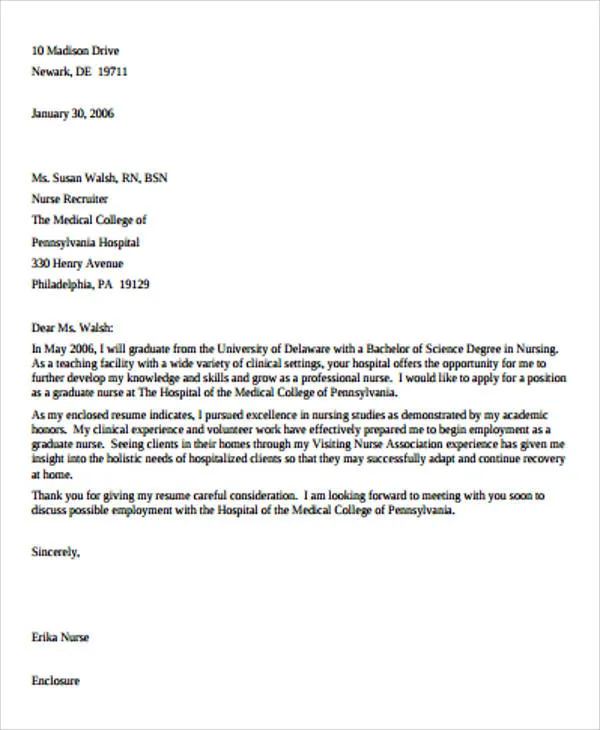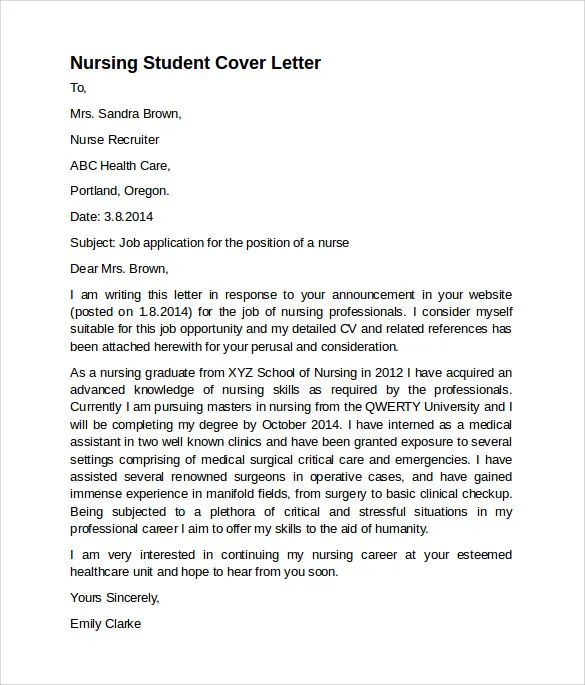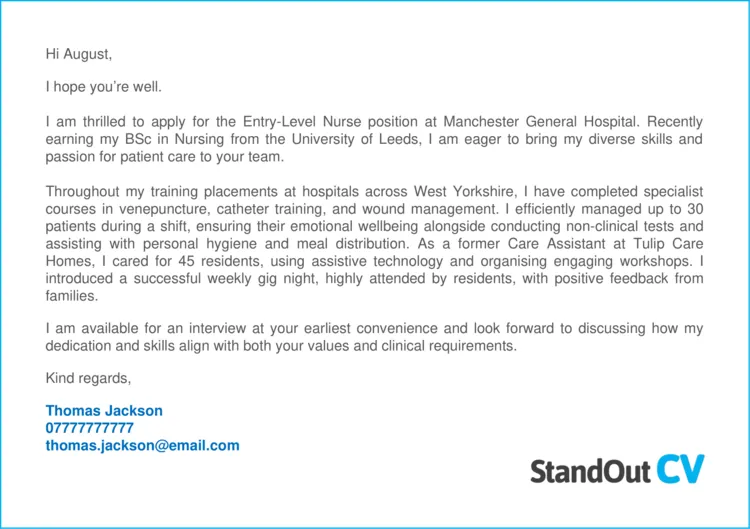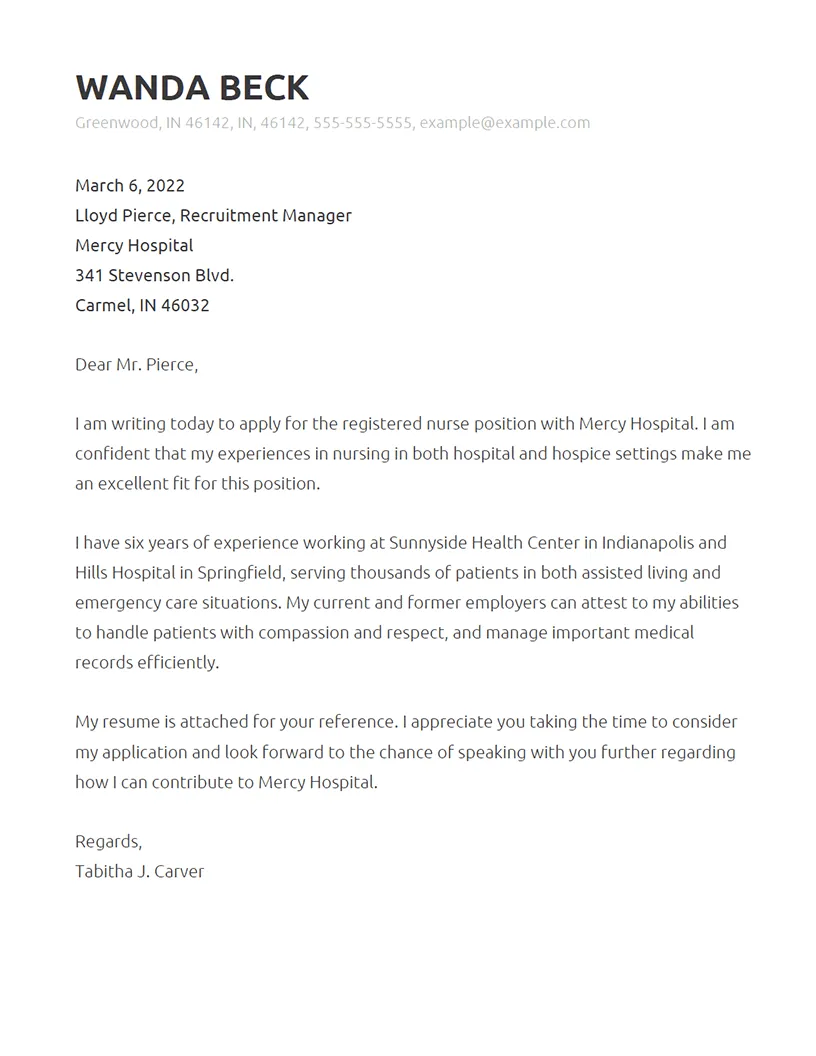Why a Cover Letter is Crucial for Nursing Students
As a nursing student, you’re likely focused on clinical rotations, studying for exams, and gaining hands-on experience. However, don’t underestimate the power of a well-crafted cover letter. In a competitive job market, a cover letter can be your secret weapon, offering a personalized introduction and highlighting your unique qualifications. It’s your chance to make a strong first impression, showcasing your passion for nursing and your suitability for the role. Unlike a resume, which provides a factual overview, a cover letter allows you to connect with the hiring manager on a more personal level. It’s where you can explain why you’re interested in the specific position and the healthcare facility, setting yourself apart from other applicants and increasing your chances of getting hired. A cover letter is a vital part of your application, providing you with an opportunity to highlight your qualifications, showcase your personality, and express your passion for nursing, ultimately increasing your chances of landing your dream job.
Highlighting Your Skills and Experience
Your cover letter is your platform to showcase the skills and experiences you’ve gained throughout your nursing education. Think beyond simply listing your clinical rotations. Instead, focus on the skills you’ve developed during each experience. For example, if you’ve completed a rotation in a medical-surgical unit, mention your experience with patient assessment, medication administration, and wound care. If you’ve volunteered at a clinic, discuss the communication skills you’ve honed while interacting with patients and their families. Your cover letter should clearly and concisely describe the skills you have gained, whether it’s critical thinking, problem-solving, or teamwork. It should describe how these skills align with the requirements of the job you’re applying for. Tailor the skills you highlight to the specific requirements of the job. Carefully review the job description and identify the key skills and qualifications the employer is seeking, and ensure your cover letter demonstrates those skills. Use concrete examples from your clinical experiences and any other relevant work or volunteer experiences.
Tailoring Your Cover Letter to the Specific Job

A generic cover letter is easily spotted and often tossed aside. Customize each cover letter for the specific job you’re applying for. This means more than just changing the name of the hiring manager and the job title. Carefully review the job description and identify the key requirements and qualifications the employer is seeking. Then, use your cover letter to demonstrate how your skills, experience, and values align with those requirements. Highlight specific experiences or achievements that directly relate to the job duties outlined in the description. Mention the specific unit or department you’re interested in working in and explain why. Show that you’ve done your research and understand the needs of the role and the organization. Demonstrating your understanding of the specific job requirements and tailoring your letter accordingly shows the hiring manager that you’re genuinely interested in the position and the organization. This is crucial for making a positive first impression and increasing your chances of getting hired.
Researching the Healthcare Facility or Practice
Before you start writing your cover letter, invest time in researching the healthcare facility or practice you’re applying to. Visit their website, read about their mission and values, and learn about the services they offer. If possible, research the specific unit or department you’re interested in working in. The more you know about the organization, the better you can tailor your cover letter to reflect your understanding of their needs and goals. Use this research to identify specific aspects of the organization that resonate with you. Maybe you’re drawn to their commitment to patient-centered care, their innovative approach to treatment, or their emphasis on teamwork. In your cover letter, mention these aspects and explain why you’re excited about the opportunity to contribute to their mission. Referencing the organization’s values and mission in your cover letter demonstrates your genuine interest and shows the hiring manager that you’ve put in the effort to understand their culture.
Writing a Compelling Opening Paragraph
The opening paragraph of your cover letter is your first and often only chance to grab the reader’s attention. It should be concise, engaging, and immediately convey your interest in the position. Start by clearly stating the position you’re applying for and where you saw the job posting. Then, briefly explain why you’re interested in this specific opportunity. What excites you about the role or the organization? Consider including a brief statement about your passion for nursing or your career goals. This could be a sentence about your commitment to providing compassionate care, your enthusiasm for learning, or your desire to make a positive impact on patients’ lives. Make sure the opening paragraph is tailored to the specific job and organization. If you know someone who works at the facility, mentioning their name can also make your letter more personal. The opening paragraph sets the tone for the rest of your letter and should be well-written and free of errors. A strong opening paragraph immediately grabs the reader’s attention and encourages them to continue reading. It is your first chance to make a positive impression and set yourself apart from other applicants.
Showcasing Relevant Clinical Experience

Your clinical experience is the heart of your nursing education, and it should be prominently featured in your cover letter. Detail the specific clinical rotations you’ve completed, including the unit or specialty, and the type of patients you cared for. Instead of simply listing your rotations, use the STAR method – Situation, Task, Action, Result – to provide specific examples of your skills and accomplishments. Describe the situation you were in, the task you were assigned, the actions you took, and the positive result you achieved. For instance, you could describe a time you identified a patient’s deteriorating condition, the actions you took to intervene, and the positive outcome you achieved. Focus on experiences that are relevant to the job you’re applying for. If the job description emphasizes experience with a particular patient population or skill, highlight those experiences in your cover letter. Include details about any special procedures you assisted with or performed independently, such as medication administration, wound care, or patient education. This is a great way to demonstrate your knowledge, your practical skills, and your ability to solve problems.
Quantifying Achievements and Responsibilities
Whenever possible, quantify your achievements and responsibilities. Instead of saying you provided excellent patient care, provide concrete examples of your accomplishments. For example, you might say you reduced patient falls by 15% through implementing fall prevention strategies. Or you could say you educated 20 patients on medication adherence. Using numbers and statistics demonstrates the impact you’ve made and provides concrete evidence of your skills and abilities. Quantifying your achievements helps to make your cover letter more compelling and memorable. When describing your responsibilities, focus on the most important duties and the outcomes you achieved. For example, if you were responsible for administering medications, mention how many patients you cared for or any specific improvements you made in patient safety. Use metrics to demonstrate your value and impact, and make your accomplishments more concrete and impressive. This will help to make your cover letter stand out from other applicants.
Demonstrating Soft Skills and Personal Attributes
While technical skills are important, employers also value soft skills and personal attributes. Your cover letter is an opportunity to highlight these qualities. Consider what makes you a good nurse. Are you compassionate, empathetic, or detail-oriented? Are you a strong communicator, a team player, or a critical thinker? Provide specific examples of how you’ve demonstrated these soft skills in your clinical experiences or other relevant situations. If you’re applying for a role that requires strong communication skills, provide an example of a time you effectively communicated with a patient or their family. If you’re applying for a team-oriented role, describe your experience working collaboratively with other healthcare professionals. Highlight your ability to handle stressful situations, your willingness to learn, and your commitment to providing high-quality patient care. Use your cover letter to show your personality and demonstrate that you’re not just a qualified candidate, but also a good fit for the organization’s culture. Showcasing your soft skills and personal attributes helps employers get a sense of your personality and see how you’ll fit in with their team.
Using Action Verbs to Showcase Accomplishments

Use strong action verbs to describe your accomplishments and responsibilities. Action verbs are words that show you taking initiative. They create a sense of energy and dynamism in your writing. They can make your accomplishments and responsibilities more compelling and memorable. Instead of saying you were responsible for, try using action verbs like assessed, administered, educated, collaborated, implemented, or monitored. For example, instead of saying you ‘assisted with wound care’, you could say you ‘administered wound care, ensuring proper healing and minimizing infection risk’. Instead of saying you ‘worked with patients’, you could say you ‘provided patient education, promoting understanding of medications and treatment plans’. Start each bullet point or sentence with an action verb. This will help to emphasize your achievements and make your cover letter more engaging. Action verbs add impact to your writing. They show that you are proactive, results-oriented, and a skilled nurse. This is important when you are trying to get a job.
Formatting and Proofreading Your Cover Letter
A well-formatted and error-free cover letter demonstrates professionalism and attention to detail. Use a standard font, such as Times New Roman or Arial, and keep the font size between 10 and 12 points. Use clear and concise language. Avoid jargon and overly complex sentences. Break up long paragraphs into shorter ones for improved readability. Use bullet points to highlight key accomplishments or responsibilities. Proofread your cover letter carefully for any grammatical errors, typos, or spelling mistakes. Have a friend, professor, or career counselor review your letter. Even minor errors can make a negative impression on a hiring manager, so proofreading is essential. Ensure your cover letter is visually appealing and easy to read. Using proper formatting and proofreading demonstrates your professionalism and attention to detail and increases your chances of making a positive impression.
Writing a Strong Closing Paragraph
The closing paragraph of your cover letter is your final opportunity to make a positive impression. Thank the hiring manager for their time and consideration. Reiterate your interest in the position and the organization. Express your enthusiasm for the opportunity and your confidence in your ability to contribute to the team. Clearly state your next steps, such as your willingness to interview. Include a call to action that encourages the hiring manager to contact you. Keep your closing paragraph brief and to the point. A strong closing paragraph reinforces your enthusiasm and leaves a lasting positive impression. It should leave the hiring manager feeling confident in your skills and excited about the prospect of an interview. A well-written closing paragraph can significantly increase your chances of getting an interview and landing the job.
Contact Information and Professional Presentation

Ensure your contact information is clearly visible at the top of your cover letter. Include your full name, phone number, email address, and LinkedIn profile URL (if applicable). Use a professional email address. Make sure your cover letter is free of any unprofessional elements, such as casual language or slang. Use a professional tone throughout the letter. Your cover letter should be printed on high-quality paper, if you’re submitting a physical copy. Your cover letter is a representation of your professional image. Presenting a polished and professional cover letter demonstrates your attention to detail and your commitment to the application process. It reinforces your qualifications and increases your chances of getting hired.
